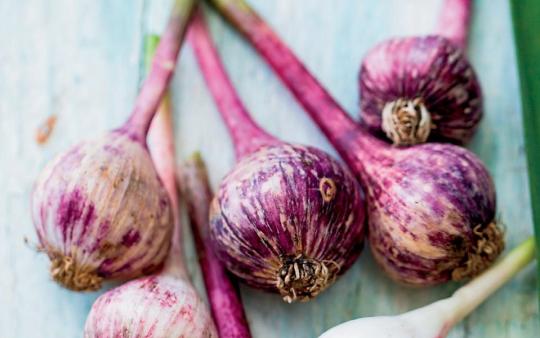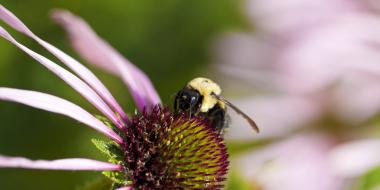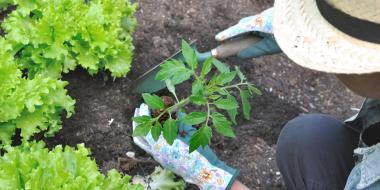Garlic is a kitchen must-have that elevates meals by infusing its savoury charm into every fragrant mouthful. Commonly available in two varieties, hardneck and softneck, garlic is a hardy favourite, with its ability to thrive in both warm and cold conditions. With so many varieties of garlic to choose from, you’re sure to find the perfect accompaniment for your garden, and your dinner plate!
Buying garlic for planting
When purchasing cloves to plant, get them from a nursery or seed seller. You may have seen on Pinterest that you can plant regular garlic cloves straight from your kitchen counter, and you certainly can. However, do so with caution: oftentimes conventional garlic is treated to prevent sprouting which means you won’t grow anything! Also, you need to be careful that you’re not inadvertently introducing pests and disease into your soil.
Hardneck vs. Softneck
Hardneck garlic is cold-hardy and produces a curly scape at the tip in early summer. The scape forms a flower head at the end with tiny garlic bulbils. The bulbils can be used for pickling, but snipping off the scapes when the head is still small and closed gives you a tasty addition to stir fry, a wonderful base for pesto, or fodder for pickling. It also makes the plant send more energy into the roots, resulting in a larger bulb. Softneck garlic does better in warmer climates, and is a great candidate for cellaring and braiding as it keeps better than hardneck. Unlike its hardneck sibling, softneck garlic does not produce scapes or bulbils that can be enjoyed mid-season.
Why garlic rocks!
it’s a natural pesticide
eases colds and earaches
cold sore eraser
athlete’s foot killer
prevents vampire attacks
great for digestive health
immune system booster
Planting garlic 101
In northern climes, hardneck is king, and should be planted as the weather turns crisp, about three weeks before frost. It might seem counterintuitive to plant anything at the end of the growing season, but these bulbs need a whole winter of sleep to be ready to burst aromatically forth in the spring! If you miss the window of fall planting, never fear! You can also plant garlic in March, or as soon as the ground thaws – or whatever passes for the end of winter in your region.
Sowing the cloves
Try to keep the spacing between garlic cloves to 4-6 inches apart with 12 inches between rows. Similarly, you can also plant double rows by staggering your plants and spacing them 8 inches apart. Keep in mind that closer planting will make for a greater overall yield but smaller bulbs will be the result. When you’re ready to plant, carefully break apart your garlic bulb into individual cloves, making sure the skin stays intact. If you break up your bulbs too early the cloves will start to dry out and will take longer to sprout. To avoid this, try and get them in the ground within 24 hours of separating the cloves. Plant each clove with the pointy tip up and the base down, 1-2 inches deep. If the ground is prone to frost heaving in your area, aim for a 2-inch depth. Protecting them with a layer of mulch can also help prevent frost-heave as well as keep soil temperatures and moisture levels stable (4-6 inches of mulch is good for colder climates; 2 inches for warmer ones). If you live in a wet climate, do not apply any mulch as it holds water – excess moisture and garlic doesn’t end happily.
Garlic's dirty secret
Did you know that 80% of the world’s garlic comes from China? This means you’ve probably bought, and most certainly have eaten, Chinese garlic more times than you were aware. So what’s the big deal? One of the biggest issues with purchasing imported foods is when the country of origin has different regulations from the destination country regarding how the product is grown and exported, often according to much lower and even harmful standards. Pesticide use, specifically toxins like methyl-bromide (typically used for pre-planting soil fumigation and which has been prohibited both in Canada and the US since 2005 because of its ozone-depleting potential) and lead have been found present on garlic imported from China. Further, this garlic may be sprayed with growth inhibitors to prevent sprouting, dipped in chlorine bleach to maintain a pure white aesthetic, and might even be treated with gamma radiation in order to lengthen its shelf life, destroying any healthful benefits associated with the bulb. Don’t settle for dirty garlic! Grow your own, buy local and organic, and ensure that you get the best that garlic has to offer!
Harvesting and keeping garlic
It’s time to harvest when most of the leaves have turned brown, typically mid-July to late August depending on your climate and the variety of garlic. Loosen the soil near the garlic bulbs and gently pull out by hand (taking care as they are prone to bruising). Leave the roots on, but remove any large chunks of dirt. Set aside any damaged bulbs for use in the near future. Ensure the garlic is well dried-out for storage by laying them on a tray in a shady, well-ventilated area for 2-3 weeks. Alternately, you can tie them together with string in bunches of 3 to 6 and hang them. Ensure that all sides of the bulb are exposed to the air for proper drying. If harvesting a softneck variety, braid the stalks together (kids will enjoy this!) and hang until ready to use.
Your garden loves garlic!
Garlic makes a great companion plant for many fruits and vegetables. It repels aphids and the sulphurs in it may help stave off whiteflies, Japanese beetle, root maggots, carrot rust fly, and other pests like vampires. It works well planted near beets, cauliflower, broccoli, lettuce, potatoes, and tomatoes, but doesn’t play well with beans or peas and can disrupt their growth! Garlic (or the scapes!) can be added to any holistic compost sprays you make for your fruiting trees and shrubs. It not only acts as a pest deterrent itself, it makes the other compounds in your tea more bioavailable to the plant by helping them to be drawn up into the cuticle of the leaves. Garlic water can also be sprayed on vegetable plants to deter squirrels and other rodents from nibbling on your hard-earned crops. So why not plant some garlic this fall? It’s as good for the garden as it is for your dinner plate!






